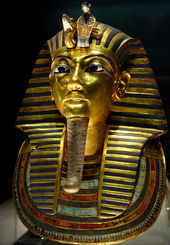
© Unkown
Al-Awsat- Tutankhamen, the golden pharaoh, continues to bedazzle the Cairo, Asharq entire world. The discovery of King Tut's tomb, which took place around 85 years ago, remains the most important archeological discovery of our time, not just in Egypt, but in the entire world.
This was the first time that a royal tomb of one of Egypt's pharaohs was discovered untouched, and with the complete set of funeral furniture which was buried with the King. In addition to this, there was also the treasures and jewelry which blinded anybody who set eyes on them. It is hard to believe that these beautifully crafted and delicate jewels were made over 3,500 years ago.
In an attempt to unravel the mystery surrounding King Tut's family and discover the identity of his father, we find that there are some archeologists who strongly suggest that this is most probably King Akhenaton. Akhenaton was the first Pharaoh to advocate monotheism, not just in ancient Egypt, but in the world. Others believe that Akhenaton's father, King Amenhotep III is a more likely candidate for Tutankhamen's father.
What about King Tut's mother? If we follow the speculation mentioned above with regards to Tutankhamen's father, his mother is most likely either Queen Tiye, the consort of King Amenhotep III or the extremely famous, Queen Nefertiti, the consort of King Akhenaton. However there are other experts who believe that Queen Kiya, who was a secondary consort of King Amenhotep III before joining Akhenaton's harem, is the most likely candidate to be King Tut's mother.
Those who support this hypothesis believe that Queen Kiya died soon after the birth of Tutankhamen. Up until now, the mummy of King Tut's mother has yet to be discovered, although a skeleton was found in tomb no.55 in the Valley of the Kings which is believed to belong to King Akhenaton himself.
The mummies of Queen Tiye, Queen Nefertiti, and Queen Kiya have yet to be discovered, however it is worth noting that several unidentified royal mummies have been discovered in the past. Whilst the Al-Qasr Al-Aini museum houses the foetus's which were unearthed by English archaeologist Howard Carter, the discoverer of Tutankhamen's tomb. They were found buried next to King Tut's sarcophagus, and there are no indications whether these are the offspring of the young pharaoh or not.
Some experts believe that the burial of these foetus's inside the tomb holds symbolic significance, in that King Tutankhamen died at a young age, symbolically in as pure a state as the foetus's, and he would therefore enjoy eternal life after death..
These questions are enigmatic, and archeologists are having a hard time trying to answer them. We have embarked upon the quest to solve the mysteries surrounding King Tut thanks to the two DNA analysis laboratories that we have access to, as well as the availability of a CT-Scan machine, through which we are able to know every single detail about a mummy.
When we first began deciding which mummies we would analyze, I stipulated the necessity of ensuring that this was an Egyptian project. There are a number of notable Egyptian experts in the field of genetics and genetic code analysis, including Dr. Yahya Zakaria, and Dr. Ashraf Salim. Both professors are being assisted by a team of young [Egyptian] scientists who have been trained to the highest level.
I never imagined that there was any hope in obtaining DNA samples from mummies; in fact I believed that we would prove to the world that mummies did not have any DNA [suitable for analysis]. However I was in for a surprise when I entered the royal tomb of Tutankhamen with Professor Zakaria, and we managed to get DNA samples. For the first time, I saw that it is possible to harvest DNA from a mummy, and I believe that this will be the key to solving the mystery surrounding King Tutankhamen's origins.
Reader Comments
to our Newsletter